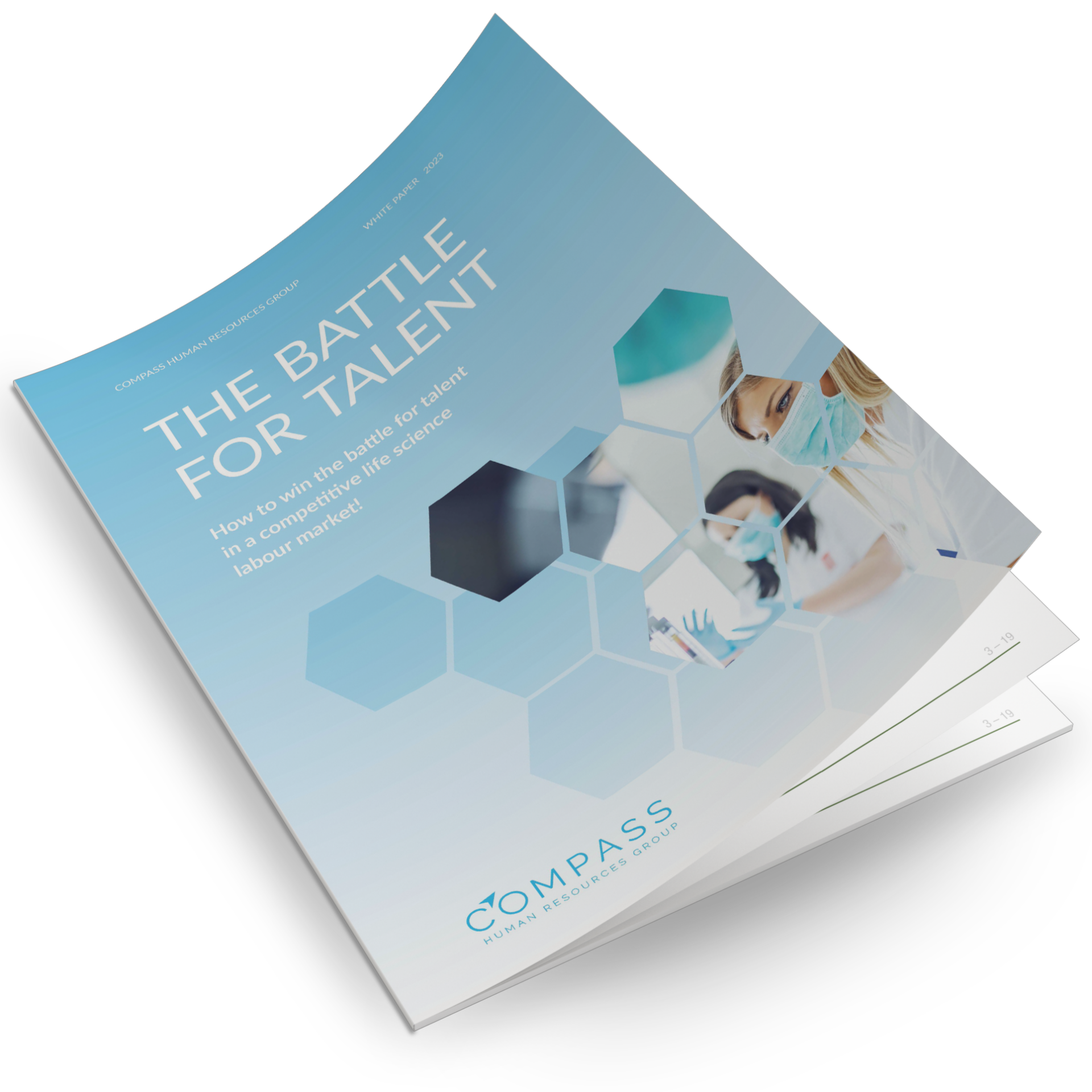Transformation in the Life Science industry: “We are seeing significant changes right now, but the long-term perspective is unchanged,” according to Rasmus Meyhoff, Partner & Practice Lead at Compass Human Resources Group.
In early 2023, we published Whitepaper, The Battle for Talent, where we conducted an in-depth analysis of the Life Science industry in Denmark from a recruitment perspective. In a three-part series of articles, we will revisit the three main challenges we identified in the Whitepaper and examine how they have evolved over the past year. In this first instalment, we focus on the competitive recruitment environment.
Macroeconomic Factors Affect the Life Science Industry’s Recruitment Environment
Over the past year, the competition for candidates in the Life Science industry has changed significantly, primarily influenced by macroeconomic factors. These changes have led to adjustments in companies’ recruitment strategies. Previously, the industry experienced fierce competition and numerous challenges, which we detailed in our January 2023 Whitepaper. But now, influenced by external factors such as global conflicts and economic shifts, there has been a different dynamic in the market.
“The most significant change has been the way in which these factors have affected the industry in the short term,” says Rasmus Meyhoff, and he elaborates: “Although they are not expected to have long-term consequences, they have nevertheless necessitated rapid adaptation and a flexible approach by companies. This development has not only shaped competition, but also opened up new opportunities and strategies in the Life Science industry.”

Do you want to read our entire whitepaper?
We focus on the industry’s main challenges from a recruitment perspective and present ten tips on how companies can meet their recruitment needs in a highly competitive market.
UNDERSTAND THE INDUSTRY
AND WIN THE BATTLE FOR TALENT
Candidates Choose Safety Over Adventure
We are seeing a trend of less risk-taking among candidates, who are increasingly looking for stability and security in their professional lives. This search for a “safe harbour” indirectly affects employee retention, as candidates are now less likely to pursue the more adventurous and risky career moves. “This is due to an understandable caution: ‘You know what you have, but not what you get,’ and with fixed expenses like bills and mortgages, many prefer the safe choice.” according to Pernille Hemmingsen, Senior Research Manager specialising in Life Science at Compass Human Resources Group.
In this context, established companies have gained a renewed appeal as more stable and secure workplaces compared to startups. A few years ago, the situation was different; Candidates were more adventurous, and startups attracted them with offers of broad leadership roles, exciting challenges and opportunities for personal development that were often not restricted by bureaucracy.
“Today, it is the stability and job security offered by more established organisations that attracts candidates. These elements represent a source of security that is increasingly needed in the current economic and societal context.” Pernille Hemmingsen elaborates.
Established Companies Are Winning the Battle In the Current Market
We have noticed a decreasing trend in the number of applicants in the Life Science industry in the recent years. While this trend has not changed significantly, a decrease in the number of job offers is also observed. Data from Jobindex confirms this, recording a 14.2% decrease in the number of job postings from 2022 to 2023.
Part of this development can be attributed to the aforementioned lack of risk-taking among candidates, which has resulted in a stagnation of job changes in the labour market. In addition, more companies seem to be reluctant to replace employees who leave the organisation until they are certain that the need still exists. “We see a clear trend towards fewer replacements in the current market, which also reflects a caution on the part of companies,” Rasmus Meyhoff elaborates.
Established companies have a clear advantage over startups in this regard. They are better equipped to secure their candidate pipeline through talent programmes. These companies also benefit from having HR and Talent Acquisition (TA) departments that can assist with strategic recruitment efforts. For example, they can help the organisation focus on securing the talent pipeline in specific candidate groups where the need is greater than in others. While this is not a new practice, the distinction has become more apparent and is now impacting the recruitment landscape to a greater degree.
Despite these internal resources in established organisations, there is still a significant need for external recruitment assistance. Even for companies with solid HR and TA departments, situations can arise where specialised recruitment support is required. This need may be due to internal circumstances that require a neutral and external perspective in the recruitment process, or specific requirements for managerial and specialist positions that internal teams may not have the capacity or network to fulfil. In addition, specialised knowledge of the candidate market and a deep understanding of the unique challenges of the Life Science industry can make a big difference. An external recruitment partner can offer this expertise, making a significant contribution to making the necessary connections between companies and the most suitable candidates, especially in a market where the requirements profile is often complex and requires an extensive search capability.
The need for specialised skills in the Life Science industry remains unchanged and highly relevant. Several large organisations are implementing strategies to recruit candidates, especially managers, from other industries. These new employees then undergo a retraining programme so they can adapt and contribute effectively to the Life Science field. This practice reflects a dynamic and flexible approach to expanding the pool of potential candidates, something we previously explored in our article “Boost your career – Change industry”.
In contrast, startups often do not have the resources to invest in such re-skilling processes. Startups need candidates who can deliver results quickly and typically don’t have the same opportunities for extensive training. “This creates a gap between established companies and startups in their approach to talent development and recruitment in an increasingly specialised labour market.” Pernille Hemmingsen elaborates.
Novo Nordisk Dominates and Slows Down the Negative Salary Spiral
In our Whitepaper, we also highlighted a potential risk regarding salary levels in the industry. Specifically, there was concern that the salaries required to attract new employees could exceed those of current employees, which in the long term would be unsustainable and potentially lead to a negative salary spiral. This concern was rooted in the assumption that increased salary demands from new employees would put pressure on existing salary structures and create internal dissatisfaction and instability.
However, current trends suggest that the rate of wage growth has begun to slow, providing a more nuanced view of the future. In our 2023 Life Science industry assessment, we see a clear example of this development in the role of Novo Nordisk. Not only has their impressive growth had a significant impact on Denmark’s overall economic growth, but their extensive recruitment efforts seem to have helped maintain relatively stable salary levels in the industry. Had there been more significant players in the market registering growth rates on par with Novo Nordisk, competition for talent would likely have driven up salary levels.
Novo Nordisk’s dominant position and their ability to attract talent, in part due to their success in launching effective obesity medication, has helped create a unique dynamic in the industry. Their status as a desirable employer has also had an impact. This positioning reflects and reinforces the trend of candidate risk aversion seen across the industry. This caution among candidates limits their mobility in the labour market and plays a crucial role in shaping the salary structure. This dynamic highlight the importance of understanding both the internal and external environment when assessing salary trends in such a specialised industry as Life Science.
Stay Focused On Long-term Strategy In a Changing Recruitment Environment
As we wrap up our analysis, it is important to recognise that the changes we are observed over the past year primarily reflect short-term trends. “These fluctuations are crucial to understanding the current recruitment landscape, but when we take a long-term view, it’s clear that the core observations and recommendations we presented in last year’s whitepaper still hold true,” says Rasmus Meyhoff, Partner & Practice Lead in Life Science at Compass Human Resources Group.
Despite the changing market trends, it remains fundamentally important for companies to continue to prioritise and strengthen their brand. Making yourself attractive to future candidates is not just a tactical manoeuvre; it is a strategic imperative that ensures companies’ ability to attract and retain talented employees in a competitive and dynamic labour market. “This long-term approach is essential to navigate and thrive in the Life Science industry, both now and in the future.” Rasmus Meyhoff concludes.

Attract and retain talent in the Life Science industry
The main challenges facing the Life Science industry in Denmark – Part 1
In the first article, we investigate the competitive recruitment landscape in Life Science and its significance for the industry. In the second part, we look closer at the candidates’ experiences and how your organisation can attract the best talents.




